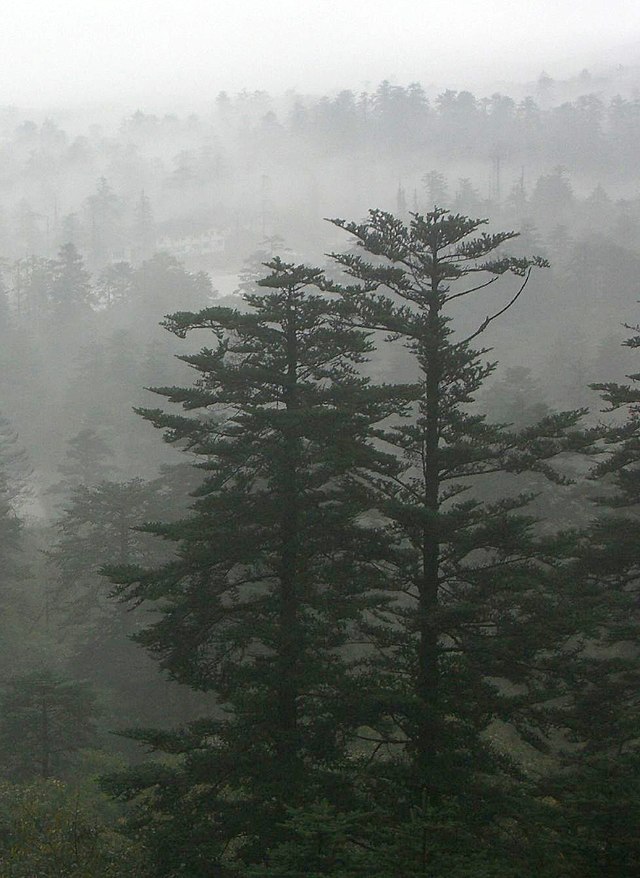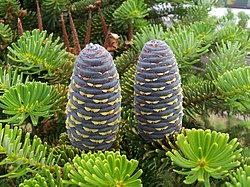Top Qs
Timeline
Chat
Perspective
Fir
Genus of coniferous trees From Wikipedia, the free encyclopedia
Remove ads
Firs are evergreen coniferous trees belonging to the genus Abies (Latin: [ˈabieːs]) in the family Pinaceae. There are approximately 48–65[2][3] extant species, found on mountains throughout much of North and Central America, Eurasia, and North Africa. The genus is most closely related to Keteleeria, a small genus confined to eastern Asia.[4]
They are tall trees that can be distinguished from other members of the pine family by the way in which their needle-like leaves are attached singly to the branches with a circular base, and by their cones, which, like those of cedars, stand upright on the branches like candles and disintegrate at maturity.
The wood of firs is used for pulp to make paper, for plywood, and for indoor construction. Some species serve as Christmas trees, while others are used as decorative trees with their brightly coloured cones. In art, Lucas Cranach the Elder painted Madonna under the fir tree for Wrocław Cathedral in 1510.
Remove ads
Etymology
The English name "fir" derives from the Old Norse fyri or the Old Danish fyr.[5] The generic name Abies is the Latin for "fir".[6]
Description
Summarize
Perspective
Fir trees are tall, often 40–60 metres and sometimes approaching 100 metres high, usually with a single straight trunk. The crown starts conical, but becomes more varied in shape with age. The primary branches are arranged in whorls around the trunk.[7]
Leaves
Firs have needle-like leaves, arranged spirally but often appearing to be in two or more rows on opposite sides of the twigs. The base of each leaf is round and attached to a small pit in the twig. Each leaf is normally twisted at its base so that the side with stomata faces downwards.[7] In the upper crown on cone-bearing branches, the leaves are shorter, curved, and sometimes sharp.[8]
- A. grandis foliage – upper side of the leaves, showing the leaves lying flat either side of the shoot
- Foliage of A. pinsapo showing the radial leaf arrangement in this species
- Most firs are in between flat and radial, often with longer leaves at the sides, and shorter leaves above the shoot; here, A. mariesii in Japan
- Cross-section of needle leaf of Abies nordmanniana
Cones
Firs differ from other conifers such as spruces in having erect, cylindrical female seed cones 5–25 cm (2–10 in) long that disintegrate at maturity to release the winged seeds. Seed cones take a year to become mature; they start out green or other bright colour, darkening as they develop to dark brown or black. The leaflike seed bracts are visible when young, and in some species remain so. The seeds sit in thin cups; each seed has a triangle-shaped wing. The male cones are pendulous (dangling) and resemble catkins; both pollen and seeds are wind-dispersed.[7]
- Intact and disintegrated Bulgarian fir cones
- Immature cones of some species are green; here Manchurian fir Abies holophylla
- Disintegrating cones of Manchurian fir
- Pindrow fir Abies pindrow with dark purple cones
- Caucasian Fir Abies nordmanniana young cones with reddish scales and yellow-green bracts
- Pollen cones
Remove ads
Evolution
Summarize
Perspective
Fossil history

The oldest pollen assignable to the genus dates to the Late Cretaceous in Siberia, with records of leaves and reproductive organs across the Northern Hemisphere from the Eocene onwards.[9]
External phylogeny
Based on transcriptome analysis, Keteleeria is sister to Abies, with the Pseudolariceae the next nearest relatives.[10]
| Pinaceae |
| ||||||||||||||||||||||||
Internal phylogeny
Phylogeny of Abies based on phylogenomic analysis in 2021:[11][12]
| Abies |
| ||||||||||||||||||||||||||||||||||||||||||||||||||||||||||||||||||||||||||||||||||||||||||||||||||||||||||||||||||||||||||||||||||||||||||||||||||||||||||||||||||||||||||||||||||||||||||||||||||||||||||||||||||||||||||||||||||||||||||||||||||||||||||||||||||||||||||||||||||||||||||||||||||||||||||||||||||||||||||||||||||||||||||
Taxonomy
Taxonomic history
In 1754, Philip Miller set up the genus Abies; he also defined the type species Abies alba.[13][14] In 1878, George Engelmann classified only a part of the genus;[13] Heinrich Mayr did the same in 1890,[13][15] as did the German botanist Wilhelm Patschke in 1913.[13] The classifications by Paul Robert Hickel in 1906 to 1908,[13][16] and by P. Landry in 1984,[13][17] made use only of a subset of the available morphological characteristics.[13] In 1990 and 2001, the Dutch botanist Aljos Farjon attempted a more complete classification; he accepted 48 species within the genus; in 2017 he reduced this to 46. Adopting a different approach, in 2011 Z. Debreczy and I. Rácz treated the genus as containing 67 species.[7]
Species
As of September 2025[update], Plants of the World Online accepted 49 species.[18] The sections are based on Stull et al. 2021.[11]
Section Abies is found in central, south, and eastern Europe and Asia Minor.
- Abies alba – silver fir or European silver fir
- Abies nebrodensis – Sicilian fir
- Abies borisii-regis – Bulgarian fir
- Abies cephalonica – Greek fir
- Abies nordmanniana – Caucasian fir or Nordmann fir
- Abies nordmanniana subsp. equi-trojani – Kazdağı fir, Turkish fir
- Abies pinsapo – Spanish fir
- Abies pinsapo var. marocana – Moroccan fir
- Abies numidica – Algerian fir
- Abies cilicica – Syrian fir
Section Balsamea is found in northern Asia and North America, and high mountains further south.
- Abies fraseri – Fraser's fir
- Abies balsamea – balsam fir
- Abies balsamea var. phanerolepis – bracted balsam fir
- Abies lasiocarpa – subalpine fir
- Abies lasiocarpa var. arizonica – corkbark fir
- Abies lasiocarpa var. bifolia – Rocky Mountains subalpine fir
- Abies sibirica – Siberian fir
- Abies sibirica var. semenovii
- Abies sachalinensis – Sakhalin fir
- Abies koreana – Korean fir
- Abies nephrolepis – Khinghan fir
- Abies veitchii – Veitch's fir
- Abies veitchii var. sikokiana – Shikoku fir
Section Grandis is found in western North America to Mexico, Guatemala, Honduras and El Salvador, in lowlands in the north, moderate altitudes in south.
- Abies grandis – grand fir or giant fir
- Abies grandis var. grandis – Coast grand fir
- Abies grandis var. idahoensis – interior grand fir
- Abies concolor – white fir
- Abies concolor subsp. concolor – Rocky Mountain white fir or Colorado white fir
- Abies concolor subsp. lowiana – Low's white fir or Sierra Nevada white fir
- Abies durangensis – Durango fir
- Abies durangensis var. coahuilensis – Coahuila fir
- Abies flinckii – Jalisco fir
- Abies guatemalensis – Guatemalan fir
- Abies guatemalensis var. guatemalensis
- Abies guatemalensis var. jaliscana
- Abies vejarii
Section Momi is found in east and central Asia and the Himalaya, generally at low to moderate altitudes.
- Abies kawakamii – Taiwan fir
- Abies homolepis – Nikko fir
- Abies recurvata – Min fir
- Abies recurvata var. ernestii – Min fir
- Abies firma – Momi fir
- Abies beshanzuensis – Baishanzu fir
- Abies holophylla – Manchurian fir
- Abies chensiensis – Shensi fir
- Abies chensiensis subsp. salouenensis – Salween fir
- Abies pindrow – Pindrow fir
- Abies ziyuanensis – Ziyuan fir
Section Amabilis is found in the Pacific Coast mountains in North America and Japan, in high rainfall areas.
- Abies amabilis – Pacific silver fir
- Abies mariesii – Maries' fir

Section Pseudopicea is found in the Sino – Himalayan mountains at high altitudes.
- Abies delavayi – Delavay's fir
- Abies delavayi var. nukiangensis
- Abies delavayi var. motuoensis
- Abies delavayi subsp. fansipanensis
- Abies fabri – Faber's fir
- Abies fabri subsp. minensis
- Abies forrestii – Forrest's fir
- Abies densa – Bhutan fir
- Abies spectabilis – East Himalayan fir
- Abies fargesii – Farges' fir
- Abies fanjingshanensis – Fanjingshan fir
- Abies yuanbaoshanensis – Yuanbaoshan fir
- Abies squamata – flaky fir
Section Oiamel is found in central Mexico at high altitudes.
- Abies religiosa – sacred fir
- Abies hickelii – Hickel's fir
- Abies hickelii var. oaxacana – Oaxaca fir

Section Nobilis (western U.S., high altitudes)
- Abies procera – noble fir
- Abies magnifica – red fir
- Abies magnifica var. shastensis – Shasta red fir
Section Bracteata (California coast)
- Abies bracteata – bristlecone fir
- ?†Abies rigida Frank Knowlton[19][20] - (Priabonian-Chattian; Colorado)
Section Incertae sedis
- †Abies milleri – (Extinct) Early Eocene[1]
Remove ads
Ecology
Summarize
Perspective
Distribution and habitat
Firs are distributed around the Northern Hemisphere. The genus is native across much of North America, Eurasia, Turkey, Syria, Morocco, and Algeria. It is introduced in Scandinavia and the British Isles.[21] Abies sibirica grows as far north as 67°N in Siberia, while A. guatemalensis grows as far south as 15°N in Central America. Most firs favour cold climates, whether at altitude in mountain ranges or at high latitude. Many species have relict distributions, occupying small areas of what were once much larger distributions. Only a few species are widespread.[7]
Abies religiosa (sacred fir) trees give roosting shelter to overwintering monarch butterflies.[22][23]
- Fir forest at high altitude,
Independence Pass, Colorado - The narrow conical shape and downward-drooping limbs of northern conifers,
like Abies lasiocarpa, help them shed snow.
Pests and diseases
Firs are hosts to a variety of invertebrate pests and fungal diseases. Pest groups include adelgid bugs, aphids, bark beetles, clearwing moths, conifer twig weevils, caterpillars of some moths, nematodes, sawflies, spider mites, and spittlebugs. Diseases of firs include annosus (Heterobasidion) root rot, cankers, and needle cast.[24]
- Galleries and larvae of Pseudohylesinus grandis beetles on Abies alba
- Pucciniastrum epilobii basidiomycete fungus infecting needle leaves of Abies alba
- Witch's broom caused by the basidiomycete fungus Melampsorella caryophyllacearum
Remove ads
Uses
Unlike the Douglas fir (Pseudotsuga), firs produce softwood, often used as pulp or for the manufacture of plywood and rough timber. It is commonly used in Canadian Lumber Standard graded wood, used for internal stud walls and similar applications.[25] Abies spectabilis is used in Ayurveda as an antitussive (cough suppressant) drug.[26] Firs produce a variety of terpenoids that could have practical uses. Terpenoid composition of the bark varies by genetics, geography, age and size of the tree.[27][28]
Caucasian fir, noble fir, Fraser's fir and balsam fir are popular Christmas trees, generally considered to be the best for this purpose, with aromatic foliage that does not shed many needles on drying out. Many form decorative garden trees, notably Korean fir and Fraser's fir, which produce brightly coloured cones even when very young, still only 1–2 m (3 ft 3 in – 6 ft 7 in) tall. Many fir species are grown in botanic gardens and other specialist tree collections in Europe and North America.[29]
Remove ads
In art
Lucas Cranach the Elder painted Madonna under the fir tree for Wrocław Cathedral in 1510.[30] The painting was taken to Germany after the Second World War for restoration, but a copy was made and substituted for the original. The forgery was discovered, partly because the copy was on a fir board where the original was on lime wood. The original was returned to Poland in 2012, the most valuable painting to be restituted to the country.[31]
- Madonna under the fir tree - Lucas Cranach the Elder, 1510
- Fir Trees in Les Trembleaux, near Marlotte - Henri Harpignies, 1854
- Simla. Fir Trees at Anandale -- Pinus Excelsa - William Tayler, c. 1858
- Fir trees heavy with snow - Bruno Liljefors, 1924
- Landscape with Fir Trees -
John Leslie Thomson (before 1929) - Landscape with Fir Trees -
David Ossipovitch Widhopff (before 1934) - Fir Trees in front of the Mountains. Study from North Norway - Anna Boberg (before 1935)
- Small picture of fir tree -
Paul Klee (before 1940)
Remove ads
See also
References
Further reading
External links
Wikiwand - on
Seamless Wikipedia browsing. On steroids.
Remove ads
































